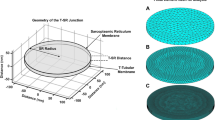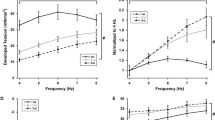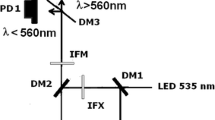Abstract
Ultrastructural features of tubular–sarcoplasmic (T–SR) triad junctions and measures of cell volume following graded increases of extracellular tonicity were compared under physiological conditions recently shown to produce spontaneous release of intracellularly stored Ca2+ in fully polarized amphibian skeletal muscle fibres. The fibres were fixed using solutions of equivalent tonicities prior to processing for electron microscopy. The resulting anatomical sections demonstrated a partially reversible cell shrinkage corresponding to substantial increases in intracellular solute or ionic strength graded with extracellular tonicity. Serial thin sections through triad structures confirmed the presence of geometrically close but anatomically isolated transverse (T-) tubular and sarcoplasmic reticular (SR) membranes contrary to earlier suggestions for the development of luminal continuities between these structures in hypertonic solutions. They also quantitatively demonstrated accompanying decreases in T–SR distances, increased numbers of sections that showed closely apposed T and SR membranes, tubular luminal swelling and reductions in luminal volume of the junctional SR, all correlated with the imposed increases in extracellular osmolarity. Fully polarized fibres correspondingly showed elementary Ca2+-release events (‘sparks’, in 100 mM-sucrose-Ringer solution), sustained Ca2+ elevations and propagated Ca2+ waves (≥350–500 mM sucrose) following exposure to physiological Ringer solutions of successively greater tonicities. These were absent in hypotonic, isotonic or less strongly hypertonic (∼50 mM sucrose-Ringer) solutions. Yet exposure to hypotonic solutions also disrupted T–SR junctional anatomy. It increased the tubular diameters and T–SR distances and reduced their area of potential contact. The spontaneous release of intracellularly stored Ca2+ thus appears more closely to correlate with the expected changes in intracellular solute strength or a reduction in absolute T–SR distance rather than disruption of an optimal anatomical relationship between T and SR membranes taking place with either increases or decreases in extracellular tonicity.
Similar content being viewed by others
References
Adrian RH, Costantin LL and Peachey LD (1969) Radial spread of contraction in frog musclefibres. J Physiol 204: 231–257.
Allen DG and Smith GL (1987) The e. ects of hypertonicity on tension and intracellular calcium concentration in ferret ventricular muscle. J Physiol 383: 425–439.
Berwe D, Gottschalk G and Luttgau HC (1987) Effects of the calcium antagonist gallopamil (D600) upon excitation–contraction cou-pling in toe muscle bres of the frog. J Physiol 385: 693–707.
Blinks RR (1965) Influence of osmotic strength on cross section and volume of isolated single muscle bres. J Physiol 177: 42–57.
Cannell MB, Cheng H and Lederer WJ (1995) The control of calcium release in heart muscle. Science 268: 1045–1049.
Caputo C, Bolanos P and Gonzalez GF (1984) Effect of membrane polarization on contractile threshold and time course of prolonged contractile responses in skeletal muscle fibers. J Gen Physiol 84: 927–943.
Caputo C and Fernandez de Bolanos P (1979) Membrane potential, contractile activation and relaxation rates in voltage clamped short muscle bres of the frog. J Physiol 289: 175–189.
Chawla S, Skepper JN, Hockaday AR and Huang CLH (2001) Calcium waves induced by hypertonic solutions in intact frog skeletal muscle fibres. J Physiol 536: 351–360.
Cheng H, Lederer WJ and Cannell MB (1993) Calcium sparks: elementary events underlying excitation–contraction coupling in heart muscle. Science 262: 740–744.
Conklin MW, Ahern CA, Vallejo P, Sorrentino V, Takeshima H and Coronado R (2000) Comparison of Ca2+sparks produced independently by two ryanodine receptor isoforms (type 1 or type 3). Biophys J 78: 1777–1785.
Conway EJ (1957) Nature and signi cance of concentration relations of potassium and sodium ions in skeletal muscle. Physiol Rev 37: 84–132.
Fabiato A (1985) Time and calcium dependence of activation and inactivation of calcium-induced release of calcium from the sarcoplasmic reticulum of a skinned canine cardiac Purkinje cell. J Gen Physiol 85: 247–289.
Franzini-Armstrong C, Heuser JE, Reese TS, Somlyo AP and Somlyo AV (1978) T-tubule swelling in hypertonic solutions: a freeze substitution study. J Physiol 283: 133–140.
Franzini-Armstrong C and Nunzi G (1983) Junctional feet and particles in the triads of fast twitch muscle fibres. J Muscle Res Cell Motil 4: 233–252.
Franzini-Armstrong C and Protasi F (1997) Ryanodine receptors of striated muscles: a complex channel capable of multiple interac-tions. Physiol Rev 77: 699–729.
Gordon AM and Godt RE (1970) Some effects of hypertonic solutions on contraction and excitation–contraction coupling in frog skeletal muscles. J Gen Physiol 55: 254–275.
Harris EJ (1963) Distribution and movement of muscle chloride. J Physiol 166: 87–109.
Hollingworth S, Peet J, Chandler WK and Baylor SM (2001) Calcium sparks in intact skeletal muscle fibers of the frog. J Gen Physiol 18: 653–678.
Huang CLH (1983) Experimental analysis of alternative models of charge movements in frog skeletal muscle. J Physiol 386: 527–544.
Huang CLH (1990) Voltage-dependent block of charge movement components by nifedipine in frog skeletal muscle. J Gen Physiol 96: 535–558.
Huang CLH (1993) Intramembrane charge movements in striated muscle. Monographs of the Physiological Society No. 44. Clarendon Press, Oxford, 292 p.
Huang CLH (1996) Kinetic isoforms of intramembrane charge in intact amphibian striated muscle. J Gen Physiol 107: 515–534.
Huang CLH (1998) The influence of perchlorate ions on complex charging transients in amphibian striated muscle. J Physiol 506: 699–714.
Iaizzo PA (1990) Histochemical and physiological properties of Rana temporaria tibialis anterior and lumbricalis IV muscle fibres. J Muscle Res Cell Motil 11: 281–292.
Jensen EB, Gundersen HJG and Osterby R (1979) Determination of membrane thickness distribution from orthogonal intercepts. J Microscopy 115: 19–33.
Keynes RD and Steinhardt RA (1968) The components of the sodium effux in frog muscle. J Physiol 198: 581–599.
Klein MG, Cheng H, Santana LF, Jiang YH, Lederer WJ and Schneider MF (1996) Two mechanisms of quantized calcium release in skeletal muscle. Nature 379: 455–458.
Kulczycky S and Mainwood GW (1972) Evidence for a functional connection between the sarcoplasmic reticulum and the extracel-lular space in frog sartorius muscle. J Physiol Pharmacol 50: 87–98.
Lipp P and Niggli E (1993) Microscopic spiral waves reveal positive feedback in subcellular calcium signalling. Biophys J 65: 2272–2276.
Lutz GJ, Bremner S, Lajevardi N, Lieber RL and Rome LC (1998) Quantitative analysis of muscle bre type and myosin heavy chain distribution in the frog hindlimb: implications for locomotory design. J Muscle Res Cell Motil 19: 717–731.
Matthias RT, Levis RA and Eisenberg RS (1980) Electrical models of excitation–contraction coupling and charge movement in skeletal muscle. J Gen Physiol 76: 1–31.
Meissner G (1994) Ryanodine receptor/Ca 2+ release channels and their regulation by endogenous effectors. Ann Rev Physiol 56: 485–508.
Murayama T and Ogawa Y (2001) Selectively suppressed Ca 2+-induced Ca 2+ release activity of a ryanodine receptor (a in frog skeletal muscle sarcoplasmic reticulum. J Biol Chem 276: 2953–2960.
Nakai J, Dirksen R, Nguyen HT, Pessah IN, Beam KG and Allen PD (1996) Enhanced dihydropyridine receptor channel activity in the presence of ryanodine receptor. Nature 380: 72–75.
Parker I and Zhu PH (1987) Effects of hypertonic solutions on calcium transients in frog twitch muscle fibres. J Physiol 383: 615–627.
Peracchia C and Mittler BS (1972) Fixation by means of glutaralde-hyde–hydrogen peroxide reaction products. J Cell Biol 53: 234–238.
Rios E and Brum G (1987) Involvement of dihydropyridine receptors in excitation–contraction coupling in skeletal muscle. Nature 325: 717–720.
Rogus E and Zierler KL (1973) Sodium and water contents of sarcoplasm and sarcoplasmic reticulum in rat skeletal muscle: effects of anisotonic media, ouabain, and external sodium. J Physiol 233: 227–270.
Rubio R and Sperelakis N (1972) Penetration of horseradish peroxi-dase into the terminal cisternae of frog skeletal muscle fibers and blockade of caffeine contracture by Ca 2+ depletion. Zeitschrift fur Zellforschung und Mikroskopische Anatomie 124: 57–71.
Schneider MF and Chandler WK (1973) Voltage-dependent charge in skeletal muscle: a possible step in excitation–contraction coupling. Nature 342: 244–246.
Shirokova N, Garcia J and Rios E (1998) Local calcium release in mammalian skeletal muscle. J Physiol 512: 377–384.
Sperelakis N, Valle R, Orozco C, Martinez-Palomo A and Rubio R (1973) Electromechanical uncoupling of frog skeletal muscle by possible change in sarcoplasmic reticulum content. Am J Physiol 225: 47–60.
Takekura H, Nishi M, Noda T, Takeshima H and Franzini-Armstrong C (1995) Abnormal junctions between surface membrane and sarcoplasmic reticulum in skeletal muscle with a mutation targeted to the ryanodine receptor. Proc Natl Acad Sci USA 92: 3381–3385.
Tsugorka A, Rios E and Blatter LA (1995) Imaging elementary events of calcium release in skeletal muscle cells. Science 269: 1723–1726.
Warley A, Powell JM and Skepper JN (1995) Capillary surface area is reduced and tissue thickness from capillaries to myocytes is increased in the left ventricle of streptozotocin-diabetic rats. Diabetologia 38: 413–421.
Yamazawa T, Takeshima H, Sakurai T, Endo M and Iino M (1996) Subtype speci city of the ryanodine receptor for Ca 2+ signal amplification in excitation–contraction coupling. EMBO J 15: 6172–6177.
Author information
Authors and Affiliations
Corresponding author
Rights and permissions
About this article
Cite this article
Martin, C.A., Petousi, N., Chawla, S. et al. The effect of extracellular tonicity on the anatomy of triad complexes in amphibian skeletal muscle. J Muscle Res Cell Motil 24, 407–415 (2003). https://doi.org/10.1023/A:1027356410698
Issue Date:
DOI: https://doi.org/10.1023/A:1027356410698




